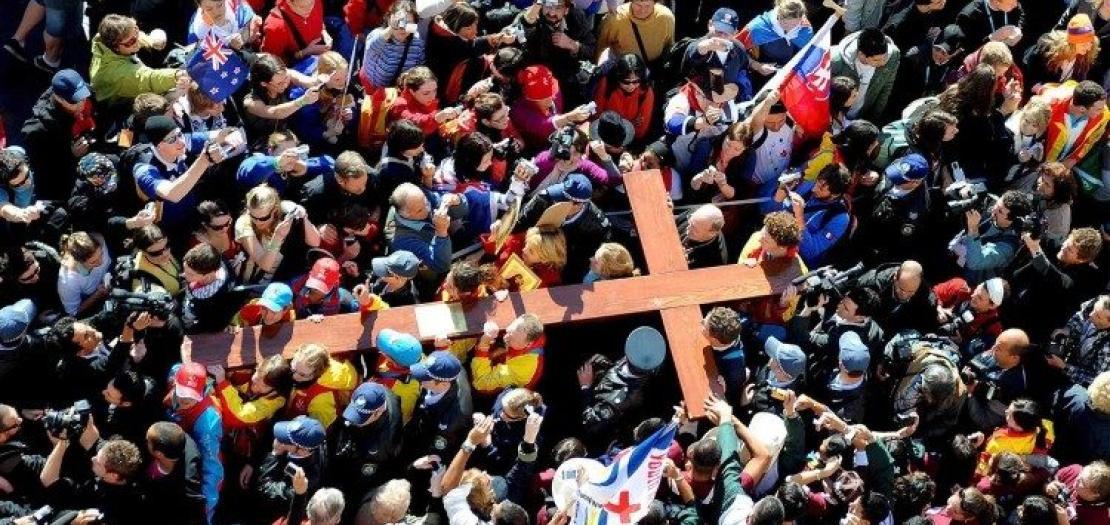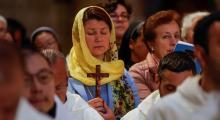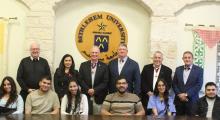Issued by the Catholic Center for Studies and Media - Jordan. Editor-in-chief Fr. Rif'at Bader - موقع أبونا abouna.org

In the Holy Land, an icon-cross has been created “ad hoc” for the Jubilee, which remains as a presence in all the Jubilee sites.
Its creation was also “ad hoc”: both in its shape, with the ends rounded and in the dimensions (120x70 cm) so that it could be used as a processional cross, and in the materials, with the choice of cedar wood, the same as the cross of Jesus, according to an age-old tradition.
The iconographer Maria Ruiz was appointed to make it, taking inspiration in the icon of the Crucifixion which she also created for the recently published Missal in Arabic.
“The Cross of Chris is vivifying, it is a death which does not end in death, this is why it is a source of hope,” the Spanish artist says. The gold that is the background to the composition symbolizes precisely this glory of the resurrection.
Cosmic cross
The iconographic model is that of the “cosmic cross,” which expresses the universality of the salvation of Christ and the gift of reconciliation granted to humanity through his love and his life which he gave on the Cross.
It is based on the words of St Paul: “For in him all the fullness was pleased to dwell, and through him to reconcile all things for him, making peace by the blood of his cross, that is, through him, whether those on earth or those in heaven.” (Col 1,19-20)
The image captures Christ at the culminating moment of his sacrifice: “And, bowing his head, he handed over the spirit.” (John 19,30) This is what the Church calls the “first Pentecost”, symbolized by the dove of the Holy Spirit: also said: , dying, is already entrusting his Spirit to the Church, born from his pierced rib.
At the two ends of the arms of the Cross, there is the personifications of the Sun (in red) and the Moon (in blue) which symbolize all the celestial elements, associated with the work of re-creation by Christ.
Under the feet of Christ, the Earth is shown as a reddish globe, the passion of Christ for humanity and again recalls what St Paul said, “(God), for he subjected everything under his feet”. (1 Cor 15,27)
The cross is lengthened downwards to contain the words “In hope we were saved” in Greek (the original language of the biblical passage), Latin and Arabic, the languages of the liturgy in the Holy Land.
A universal message (and a style)
As for the Missal, Maria Ruiz used a style “rich in ancient Christian traditions which have gone through this land and capable of speaking to Christians today, both Oriental and those of the Latin tradition.”
The Byzantine style - in particular the Armenian tradition – is the one which inspired her the most and which “allows sending a universal message.” “It is not an interpretation of mine of the crucifixion. I obeyed a certain language to convey in a more transparent way a message which is not mine.”
Work, faith and prayer
Maria’s work table contain: chalk, glue, paints, gold leaf and paintbrushes. After preparing the wood (at the “Piccirillo Centre” in Bethlehem), the plastering was done, following by the gilding and then the painting, “according to the traditional iconographic method: a dark background against which the strokes of light emerge which give shape to the body and the faces.”
Everything takes life in faith and prayer: “You cannot create a work like this without believing in the message of hope that the Cross is, which this image wishes to carry.”
“As I paint, I carry in my prayer all the people who will worship this image, with a heart reconciled with God, and I ask that this reconciliation reaches those people who meet Christ through this Cross.”
For Maria Ruiz “it was the hardest job I have ever done,” due to the time it took but also for the personal moment I was going through. “There is always a time when I feel that the divine presence inhabits the icon which is not the result of my efforts. This time I experiences the abyssal distance between what I was representing and what I am, a distance that cannot be filled without the grace of God.”
Seeing the cross in the hands of the Patriarch entering the Basilica of the Annunciation in Nazareth on the day the Jubilee opened, “was an immense joy and a great grace: what is not the symbol of hope for this year, for the diocese, passed through my hands.”
A presence that is always new
After the first cross, Maria began to work on the crosses for the other Jubilee sites.
“They are not replicas. It is not a case of repeating something I knew the shape of, the elements and colors... The meeting with the Crucifix is always unique, always new. It is like meting a person you know but at the same time you never end getting to know them. It is not enough having met Jesus yesterday, it is a presence to meet today.”







